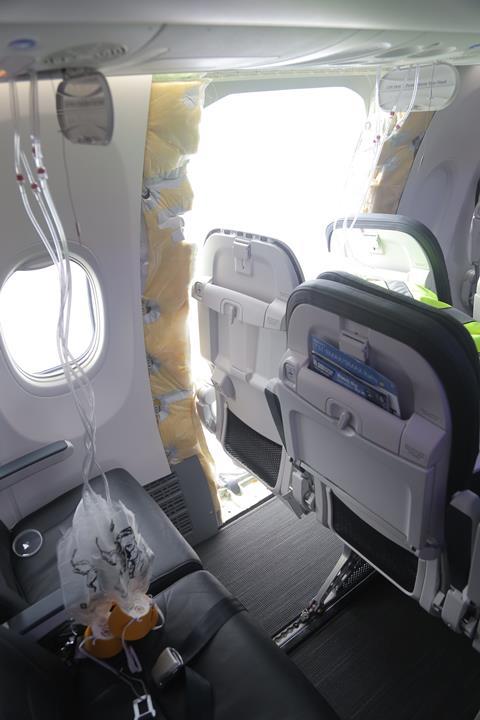The US National Transportation Safety Board (NTSB) says Boeing “blatantly violated NTSB investigative regulations” when it publicly disclosed information relevant to the investigation of the 5 January Alaska Airlines Boeing 737 Max 9 door-plug blowout.
In addition, on 27 June the NTSB alleged that the airframer “offered opinions and analysis” about possible causes of the incident to journalists at a briefing in Seattle earlier this week.
As a result, Boeing will no longer be privy to NTSB investigative information related to the event, the US safety watchdog adds.

“During a media briefing [on] Tuesday about quality improvements at Boeing Commercial Airplanes, a Boeing executive provided investigative information and gave an analysis of factual information previously released,” the NTSB says. “Both of these actions are prohibited by the party agreement that Boeing signed when it was offered party status by the NTSB at the start of the investigation.
“As a party to many NTSB investigations over the past decades, few entities know the rules better than Boeing,” the safety agency adds.
Boeing will retain its party status, but will no longer have access to NTSB investigative information. In addition, the NTSB plans to subpoena the company to appear at a hearing on 6 and 7 August in Washington DC.
On 5 January, a mid-cabin door plug blew out of an Alaska 737 Max 9 airframe as it was departing Portland. That failure caused a rapid depressurisation, leaving a gaping hole in the left side of the jet. The pilots landed the aircraft safely and no passengers or crew members were seriously injured.
The incident led the Federal Aviation Administration (FAA) to ground all Max 9 jets with the door plugs, pending additional inspections.

According to the NTSB’s preliminary accident report, published in February, the four bolts intended to secure the door plug were missing when the plug failed. It suggested Boeing may not have installed the bolts prior to delivering the jet to Alaska. During production, Boeing employees removed the plug so workers for fuselage supplier Spirit AeroSystems could fix defective rivets. When replacing the plug, Boeing did not bolt it back in place.
The incident led to a safety audit, a management shake-up and a great deal of soul searching at the company. An FAA safety audit revealed further safety issues.
Earlier this week, executives told journalists during a press visit of the 737 production site in Renton, Washington that the company is “dedicated to making air transportation as safe as humanly possible”.
“I am extremely confident that every airplane exiting this factory is safe,” Boeing senior vice-president of quality Elizabeth Lund said on 25 June. “We are a transparent company who cares deeply about safety”.


























